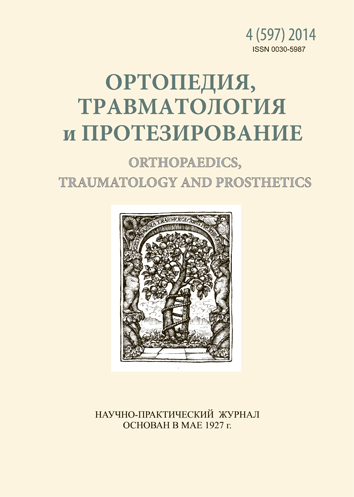Investigation of articulating surfaces of single-pole endoprosthesis of the femoral head
DOI:
https://doi.org/10.15674/0030-59872014431-35Keywords:
proximal femur, unipolar endoprosthesis, metallosisAbstract
Unipolar hip replacement after femoral neck fracture in elderly patients enables them to move independently as soon as possible but complications in the late period stipulate to the search for new design solutions. Objective: To investigate the qualitative and chemical characteristics of the heads of single-pole hip joint endoprostheses made of titanium and stainless steel. Methods: The medical records of patients with late complications after unipolar hip replacement were studied. Using a microscope and spectrometer ElvaX MSB-2 we investigated 12 endoprosthesis removed after complications, fragments of bone cement and bone tissue from the area of inflammation. Results: Decreasing of the part of iron on 1 %, molybdenum on 8.3 % in local wear of the upper pole of the implant head made of stainless steel was revealed but the amount of nickel, chromium and manganese remained unchanged. In the case of surface defect there was decreasing of the part of chromium on 24.6 %, molybdenum on 20.8 %, and manganese on 80 %. In bone tissue adjacent to the neck of the implant chrome chromium (1.1 %) and iron (0.8 %) were detected. In the regions of wear on the surface of titanium heads there was detected decreasing in the proportion of titanium on 1.4 % increasing in the ratio of calcium and potassium on 3.3 times, and the ratio of molybdenum, vanadium, iron, scandium remained unchanged. In bone tissue nearby the neck of the implant titanium was discovered up to 0.8 %. Conclusion: the biological environment of the human body on the surface of the endoprosthesis made of titanium and stainless steel active chemical processes occur. Protective bioinert coating of the head of the unipolar endoprosthesis should extend its work and to improve the tribological properties its surface.
References
- Flecher X. Managment of severe bone loss in acetabular revision using a trabecular metal shell / X. Flecher, S. Sporer, W. Paprosky // J. Arthroplasty. — 2008. — Vol. 23 (7). — P. 949–955.
- Matthew A. Severe metal-induced osteolysis many years after unipolar hip endoprosthesis / A. Matthew, D. Tanzer, M. Tanzer // CORR. — 2013. — Vol. 471 (7). — Р. 13.
- Mody D. R. A histologic study of soft-tissue reactions to spinal implants / D. R. Mody, S. I. Esses, M. H. Heggeness // Spine. — 1994. — Vol. 18. — P. 1153–1156.
- Paprosky W. G. Addresing severe bone deficiency what a cage will not do / W. G. Paprossky, S. S. Sporer, B. P. Murphy // J. Arthroplasty. — 2007. — Vol. 22, Suppl. 1. — P. 111–115.
- Reconstruction of massive uncontained acetabular defects using allograft with cage or ring reinforcement an assessment of the graft’s ability to restore bone stock and its impact on the outcome of re-revision / M. Abolghasemian, M. Sadeghi Naini, P. Lee [et al.] // Bone Joint J. — 2014. — Vol. 96-B. — P. 319–324.
- The use of the transverse acetabular ligament in total hip replacement. An analysis of the orientation of the trial acetabular component using a navigation system / K. Fujita, T. Kabata, T. Maeda [et al.] // Bone Joint J. — 2014. — Vol. 96-B. — P. 306–311.
- Zykova A. The improvement of tribological parameters of nano structural multilayer coatings for unipolar modular joint applications / A. Zykova, V. Safonov, V. Lukyanchenko // Ортопедия, травматология и протезирование. — 2014. — № 1. — С. 28–33.
Downloads
How to Cite
Issue
Section
License
Copyright (c) 2014 Olexsandr Samoilenko, Volodimir Lukyanchenko, Volodimir Dubonosov, Andrey Krut

This work is licensed under a Creative Commons Attribution 4.0 International License.
The authors retain the right of authorship of their manuscript and pass the journal the right of the first publication of this article, which automatically become available from the date of publication under the terms of Creative Commons Attribution License, which allows others to freely distribute the published manuscript with mandatory linking to authors of the original research and the first publication of this one in this journal.
Authors have the right to enter into a separate supplemental agreement on the additional non-exclusive distribution of manuscript in the form in which it was published by the journal (i.e. to put work in electronic storage of an institution or publish as a part of the book) while maintaining the reference to the first publication of the manuscript in this journal.
The editorial policy of the journal allows authors and encourages manuscript accommodation online (i.e. in storage of an institution or on the personal websites) as before submission of the manuscript to the editorial office, and during its editorial processing because it contributes to productive scientific discussion and positively affects the efficiency and dynamics of the published manuscript citation (see The Effect of Open Access).














